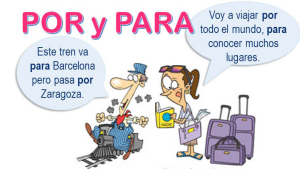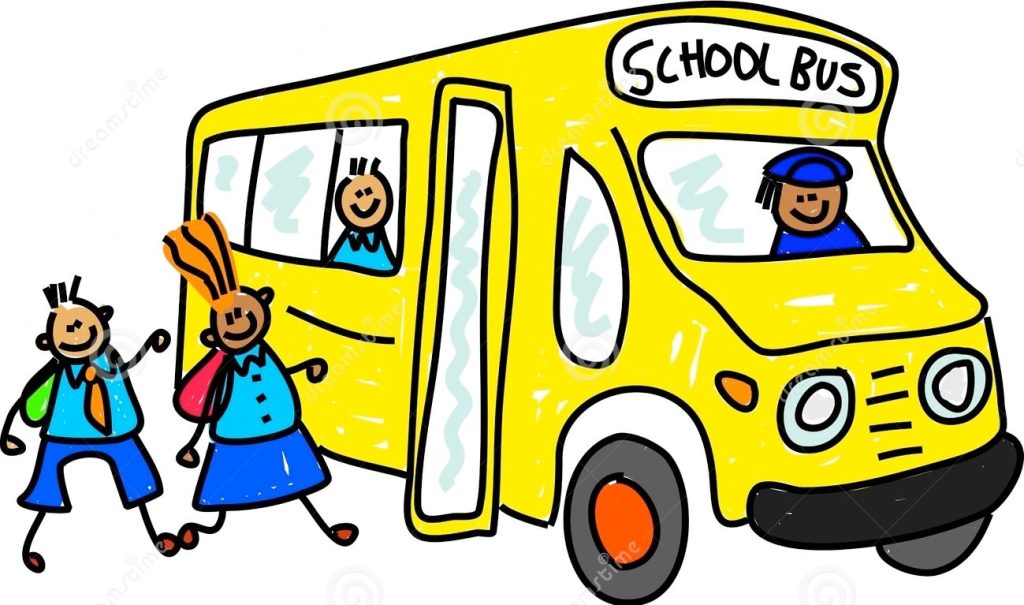11.3 Gramática: Por vs. Para
11.3 Gramática: Por vs. Para
Depending on the context, Spanish has two words for por and para. These two prepositions are not interchangeable. Please study the following chart to see how they are used.
| POR – I’M ATTRACTED MORE | |
| I – *Idiomatic expressions | |
| M – Movement: Motion or a general location (around, through, along, by) | Caminé por el parque ayer con mi perro. I walked through the park with my dog. |
| A – Apology / Emotion | Siento mucho amor porti. I feel a lot of love for you. |
| T – Thanks | Gracias por tu ayuda. Thanks for your help. |
| T – Transportation / Communication | Yo viajé en Europa por tren. I traveled in Europe by train.¿Quieres hablar por teléfono? Do you want to talk on the phone? |
| R – Reason / Cause for an action (because of, due to) | No fuimos a la fiesta por la lluvia. We didn´t go to the party because of the rain. |
| A – Amount of time: duration of an action (for, during) | Anoche estudié por dos horas. Last night I studied for two hours. |
| C – Cost / Value | Compré el teléfono por 600 dólares. I bought my phone for $600. |
| T – To be accomplished (*yet to happen) | La clase está por terminar. The class is about to end. |
| E – Exchange / Substitution (for, in exchange for) | Te doy 20 dólares por esos boletos. I will give you 20 dollars for those tickets. |
| D – Disposition / Mood / In favor (about to do…) | Estoy por llamarte. I am about to call you. |
| M – Mistaken Identity | Me confundieron por mi hermana. They mistook me for my sister. |
| O – On behalf of | Mi amiga trabajó por mí ayer. My friend worked for me yesterday. |
| R – Rate / Measurement | Ella manejaba a 120 kilómetros por hora. She was driving 120 kilometers per hour. |
| E – Errand | Voy al supermercado por frutas. I am going to the supermarket to get fruit. |

*Common Idiomatic Expressions with POR
| por ahora | for now |
| por aquí | around here |
| por casualidad | by chance |
| por Dios | for God’s sake |
| por ejemplo | for example |
| por eso | that’s why |
| por favor | please |
| por fin | finally |
| por lo general | in general |
| por si acaso | just in case |
| ¡por supuesto! | of course! |
| por todas partes | everywhere |
| por último | finally |
| por si las moscas | just in case |
| Para – PERFECTO |
|
| P – Purpose (+ noun) (use of something) | El libro es para traerlo a la clase. The book is to be brought to class. |
| E – Expectation / Goal (in order to) | Estudio para ser enfermera. I am studying to be a nurse. |
| R – Recipient | Este regalo es para ti. This gift is for you. |
| F – Future / Deadlines | La tarea es para mañana. The homework is due tomorrow. |
| E – Employment (who you work for) | La profesora trabaja para MCC. The instructor works for MCC. |
| C – Comparison / Contrast (from what´s expected) | Mi carro funciona bien para ser del año 1998. My car works well for a 1998. |
| T – Toward a specific (destination) | El próximo verano voy para España. Next summer I am going to Spain. |
| O – Opinion | Para mí, ser bilingue es muy importante. For me, being bilingual is very important. |
 Actividad # 1
Actividad # 1
¿POR o PARA? Fill in the blank with either por or para, depending on the situation in each sentence. Then, write the reason you think your choice is correct.
1. Tengo que leer este libro ________ mañana.
2. Yo estudio _________ ser una ingeniera eléctrica.
3. Mario, ¿puedes trabajar _______ mi el próximo sábado, por favor?
Quiero ir a un concierto.
4. Mis estudiantes llegan a la universidad _______ autobús.
5. Yo estuve en España ________ tres meses el año pasado.
6. Cuando viajo a California, voy _________avión.
7. Papá, gracias _______ ayudarme.
8. Yo siempre voy al gimnasio ________ la mañana.
¡Inténtalo!
 Actividad # 2
Actividad # 2
Describir. Using por or para write a complete sentence describing each image.
1. Los niños 
________________________________________.
2. Él 
________________________________________.
3. La caja 
________________________________________.
4. El chico 
________________________________________.
5. La tarea (mañana) 
________________________________________.
6. Pagué ($500) 
________________________________________.
¡Inténtalo!
 Actividad # 3
Actividad # 3
¡Vámonos de viaje! Work with a compañero (a) think about a place you would like to visit. Answer the following questions to help you plan your trip. Then, make a
summary of your plans.
- ¿Para qué quieren hacer este viaje?
- ¿Para cuándo es el viaje?
- ¿A qué hora quieren salir, por la mañana, por la noche?
- ¿Cómo van a viajar?
- ¿Por cuánto tiempo piensan ir?
- ¿Cuánto dinero necesitan para este viaje?
Resumen (Summary):
__________________________________________________________
__________________________________________________________
__________________________________________________________
__________________________________________________________.
 Actividad # 4
Actividad # 4
Una entrevista con Fernando Botero.
Paso 1. Read the following interview and underline the prepositions por and para. Then, explain why they were used.
Ejemplo: ¿Por qué fue a México? (reason or cause)
Entrevistadora: Buenos días, señor Botero, gracias por esta entrevista. Usted nació y estudió en Medellín pero se fue a vivir a Bogotá. ¿Por qué tomó esa decisión?Botero: Me fui para Bogotá porque había más oportunidades. Allí, tuve dos exposiciones y gané un premio. Después de eso, decidí viajar a Europa.Entrevistadora: ¿Y qué hizo en Europa?Botero: Primero, viajé a España para estudiar la pintura de Goya y Velázquez en especial. Luego, viajé por Francia e Italia para conocer las grandes obras maestras en los museos europeos. Estudié por varios meses en cada lugar, y luego me fui para México.Entrevistadora: ¿Y por qué fue a México?Botero: Fui para conocer la obra de los muralistas mexicanos. Sin embargo, para mí, la pintura del mexicano Rufino Tamayo fue una influencia y creé mi propio estilo. Después de México, me fui para Nueva York.Entrevistadora: ¿Tuvo exposiciones en Nueva York?Botero: Sí, en 1957 tuve una exposición exitosa. También allí pinté mi cuadro Mona Lisa que ahora está en el Museo de Arte Moderno.Entrevistadora: Muchas gracias por su tiempo. |
![]() Paso 2. Answer the following questions based on the interview.
Paso 2. Answer the following questions based on the interview.
1. ¿Cuál es la nacionalidad de Botero?
2. ¿Por qué se mudó a Bogotá?
3. ¿Para qué viajó a España?
4. ¿Dónde está uno de sus cuadros en los E.E. U.U.?

